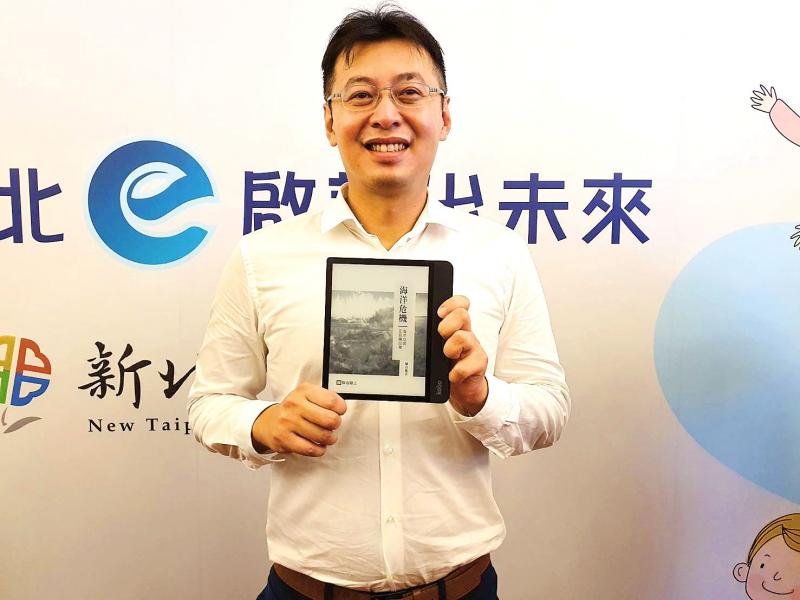E Ink Holdings Inc (元太科技), the world’s sole supplier of e-paper displays, yesterday said that it expects revenue to rise mildly this quarter from last quarter — bucking a downturn in the electronics industry — as the COVID-19 pandemic continues to drive demand for e-readers, e-notes and electronic shelf labels (ESL).
E Ink’s revenue for last quarter surged 22 percent to NT$4.45 billion (US$154.42 million) from NT$3.66 billion in the same period last year.
“The fourth quarter looks strong. That is primarily because of strong demand for e-paper displays, used e-readers and ESL, as well as new applications like e-notes and signs,” E Ink chairman Johnson Lee (李政昊) told investors in an online conference.

Photo: Chiu Shu-yu, Taipei Times
Demand for ESL has surpassed the company’s expectations this year, Lee said.
The Hsinchu-based company said that the estimated revenue growth would also be fueled by demand for e-readers with color displays or bigger screens, such as 10-inch models, or models equipped with a stylus.
Retailers in Portugal and India are joining their global peers in adopting ESL to boost operational efficiency and cope with labor shortages amid pandemic-driven lockdowns, E Ink said.
The global ESL penetration rate is 5 percent, indicating an ample room for growth, it said.
Visibility for the first half of next year is good, Lee said.
The firm said that it is “relatively bullish” about demand for next year and beyond.
To cope with strong demand, E Ink is accelerating capacity expansion and next year plans to invest NT$800 million to NT$1 billion in new manufacturing equipment in Hsinchu and Boston.
Capital expenditure this year might rise to NT$1 billion, higher than NT$600 million to NT$800 million over the past few years, it said.
In the July-to-September quarter, net profit shrank 28 percent to NT$824 million from NT$1.15 billion a year earlier, mostly due to an unrealized asset impairment loss of NT$100 million amid volatile foreign exchange rates, it said.
Operating income soared 190 percent to NT$822 million from NT$284 million a year earlier, the highest in nine years, it said.
The company reported gross margin of 48.2 percent for last quarter, a record.
E Ink financial executive Lloyd Chen (陳樂群) attributed the results to the effects of remote working and online learning amid the pandemic.
In the first three quarters, net profit expanded 5 percent to NT$2.59 billion, compared with NT$2.47 billion in the same period last year, or a rise on earnings per share to NT$2.28 from NT$2.18.

Nvidia Corp’s demand for advanced packaging from Taiwan Semiconductor Manufacturing Co (TSMC, 台積電) remains strong though the kind of technology it needs is changing, Nvidia CEO Jensen Huang (黃仁勳) said yesterday, after he was asked whether the company was cutting orders. Nvidia’s most advanced artificial intelligence (AI) chip, Blackwell, consists of multiple chips glued together using a complex chip-on-wafer-on-substrate (CoWoS) advanced packaging technology offered by TSMC, Nvidia’s main contract chipmaker. “As we move into Blackwell, we will use largely CoWoS-L. Of course, we’re still manufacturing Hopper, and Hopper will use CowoS-S. We will also transition the CoWoS-S capacity to CoWos-L,” Huang said

Nvidia Corp CEO Jensen Huang (黃仁勳) is expected to miss the inauguration of US president-elect Donald Trump on Monday, bucking a trend among high-profile US technology leaders. Huang is visiting East Asia this week, as he typically does around the time of the Lunar New Year, a person familiar with the situation said. He has never previously attended a US presidential inauguration, said the person, who asked not to be identified, because the plans have not been announced. That makes Nvidia an exception among the most valuable technology companies, most of which are sending cofounders or CEOs to the event. That includes

INDUSTRY LEADER: TSMC aims to continue outperforming the industry’s growth and makes 2025 another strong growth year, chairman and CEO C.C. Wei says Taiwan Semiconductor Manufacturing Co (TSMC, 台積電), a major chip supplier to Nvidia Corp and Apple Inc, yesterday said it aims to grow revenue by about 25 percent this year, driven by robust demand for artificial intelligence (AI) chips. That means TSMC would continue to outpace the foundry industry’s 10 percent annual growth this year based on the chipmaker’s estimate. The chipmaker expects revenue from AI-related chips to double this year, extending a three-fold increase last year. The growth would quicken over the next five years at a compound annual growth rate of 45 percent, fueled by strong demand for the high-performance computing

TARIFF TRADE-OFF: Machinery exports to China dropped after Beijing ended its tariff reductions in June, while potential new tariffs fueled ‘front-loaded’ orders to the US The nation’s machinery exports to the US amounted to US$7.19 billion last year, surpassing the US$6.86 billion to China to become the largest export destination for the local machinery industry, the Taiwan Association of Machinery Industry (TAMI, 台灣機械公會) said in a report on Jan. 10. It came as some manufacturers brought forward or “front-loaded” US-bound shipments as required by customers ahead of potential tariffs imposed by the new US administration, the association said. During his campaign, US president-elect Donald Trump threatened tariffs of as high as 60 percent on Chinese goods and 10 percent to 20 percent on imports from other countries.